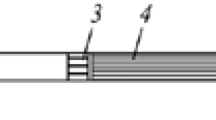Abstract
The fundamental cooling parameters, the cooling constant k, the heat transfer coefficient h, and the ultimate steady state temperature T′, are explained and the methods for their determination are described. The conversion of k to a percentage, r%(T − Ta)/t, provides an understandable number which is useful for comparing the relative rates of cooling of different systems under different conditions. h is indispensable for coefficient calorimetry and T′ can be used to calculate separately the heat input from local generation and from blood circulation.
Zusammenfassung
Die wesentlichen Abkühlungsparameter, die Abkühlungskonstante k, der Wärmeüberleitungskoeffizient h und die äusserste steady state Temperatur T′, werden erklärt und die Methoden zu ihrer Bestimmung beschrieben. Die Umkehrung von k in Prozent, r%(T−Ta)/t, ergibt eine verständliche Zahl, die beim Vergleich der relativen Abkühlungsraten verschiedener Systeme bei unterschiedlichen Bedingungen nützlich ist. h ist unersetztlich für Koeffizient-Kalorimetrie und T′ kann zur Berechnung der Wärmeeingabe durch lokale Bildung und Blutzirkulation benutzt werden.
Resume
On définit ici les principaux paramètres du refroidissement (la constante de refroidissement k, le coefficient de transfer de chaleur h et la température finale de l'état d'équilibre T′) et on indique les méthodes permettant leur détermination. La conversion de k en une valeur relative, r%(T−Ta)/t, donne une grandeur compréhensible qui est utile lors de la comparaison des taux de refroidissement relatifs de divers systèmes soumis à des conditions variables. h ne peut être remplacé dans le coefficient de calorimétrie et T′ peut être utilisé dans le calcul séparé de l'apport de chaleur, soit par formation locale, soit du fait de la circulation sanguine.
Similar content being viewed by others
References
BEDFORD, T. (1937): The measurement of environmental warmth. Trans.Inst. Mining Eng., 94: 76–89.
HILL, L. (1913): The physiology of open-air treatment. Lancet, 184: 1285–1290.
MOLNAR, G. W. (1967a): Device for the determination of the heat transfer coefficients for body segments. Digest 7th Int. Conf. Med. Biol. Eng. (Stockholm), p. 393.
MOLNAR, G.W. (1967b): Coefficient calorimetry of body segments. Fed. Proc., 26: 556.
MOLNAR, G.W. (1968): Factors which cause deviation from Newton's law of cooling. Proc. Ann. Conf. Eng. Med. (Houston), 10: 19–1.
MOLNAR, G.W. (1969a): Newton's thermometer: a model for testing Newton's law of cooling. Physiologist, 12: 9–19.
MOLNAR, G.W. (1969b): Newton's law of cooling applied to Newton's ingot of iron and to other solids. Physiologist, 12: 137–151.
MOLNAR, G.W., HURLEY, H.J. and FORD, R. (1969): Application of Newton's law to the post mortem cooling of the human body. Pflüg.Arch.ges.Physiol., 311: 16–24.
Author information
Authors and Affiliations
Additional information
Presented during the Fifth International Biometeorological Congress, 1–6 September 1969, Montreux, Switzerland.
Rights and permissions
About this article
Cite this article
Molnar, G.W. The determination of the parameters of cooling. Int J Biometeorol 14, 267–274 (1970). https://doi.org/10.1007/BF01742070
Received:
Issue Date:
DOI: https://doi.org/10.1007/BF01742070




